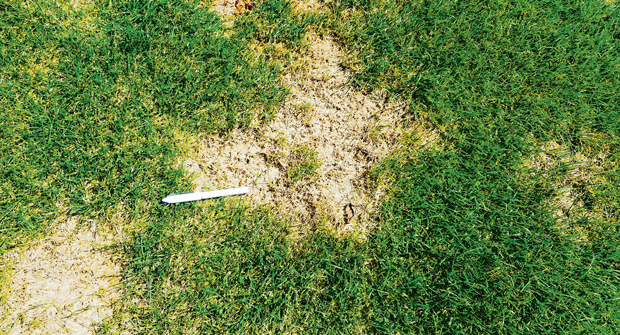
Brown and summer patch are a pair of pesky turf diseases that can cause headaches for both lawn care operators (LCOs) and their customers.
Often found on cool-season turfgrass, these diseases can lead to an LCOs worst nightmare, dead turf, says Brian Aynardi, Ph.D., Northeast research scientist for PBI-Gordon.
“Summer patch may result in significant patches of dead turf that present in the middle of the summer following periods of significant rainfall followed by hot weather,” he says. “Brown patch may not kill the turf, but it will result in diffuse brown patches that are visually unattractive.”
Aynardi shares what LCOs need to know about these two potentially harmful turf diseases.
The disease triangle
As with most turfgrass diseases, brown patch requires a specific set of environmental conditions to develop, including temperatures greater than 85 degrees F during the day and 65 degrees F at night and 10 hours or more of free-leaf moisture — or high humidity.
“Brown patch will cause lesions, specifically, angular tan lesions surrounded by a dark brown border,” says Aynardi. “(LCOs can ID brown patch through) ‘smoke rings’ (which) are dark areas of active infection present at the edges of the patches and are typically seen during cloudy weather or early in the day. On occasion, there may be small amounts of aerial mycelia observed with patches.”
Brown patch is most problematic on tall fescue and ryegrass but also occurs on bluegrass and fine fescue. Turf with excessive nitrogen or inadequate levels of phosphorus and potassium can also be conducive to large outbreaks.
Conversely, summer patch doesn’t require specific environmental conditions. Rather, according to Aynardi, symptoms will be present during hot weather following significant rainfall — or the overwatering of a lawn.
LCOs can identify summer patch by looking for small patches or crescent-shaped patches of tan/bleached turf. Those that can expand and coalesce as the disease progresses. Summer patch often occurs on Kentucky bluegrass, annual bluegrass and fine fescues.
Aynardi adds that there will be no fungal structures visible in the canopy or specific lesions on plants. LCOs can also ID summer patch by pulling up affected plants from the turf to reveal black roots, crowns and rhizomes.
Treatment options
In terms of ingredients, treatment options for brown and summer patch have remained largely the same for LCOs in recent years. However, according to Aynardi, there are newer combination products — usually a strobilurin and a DMI fungicide — that have proven to be effective in controlling both diseases.
For brown patch specifically, LCOs should reserve applications for when the environmental conditions are conducive for the disease. These products, commonly including the active ingredients azoxystrobin and propiconazole, should be left on the turf after application.
If summer patch is a worry, LCOs should use preventive applications when the 2-inch soil temperatures reach 65 degrees F in late spring, according to Aynardi.
“Since the pathogen that causes the disease affects the roots and rhizomes, immediate post-treatment irrigation to get the product to the soil is essential, with 1/8-inch of irrigation being optimal,” he continues.
Cultural practices
LCOs can assist turf in fighting off brown and summer patch with several cultural practices as well. For brown patch, Aynardi recommends regular mowing to reduce relative humidity and promote drying of the canopy. He adds that, if possible, LCOs should ensure irrigation does not occur at night as it promotes extended leaf wetness.
Similarly, cultural practices to reduce summer patch start with water management.
“Ensure there isn’t excessive irrigation prior to extended periods of hot weather in the summer,” Aynardi says. “(LCOs) can also look to plant species that are non-hosts to the summer patch pathogen such as turf-type tall fescue or perennial ryegrass.”


